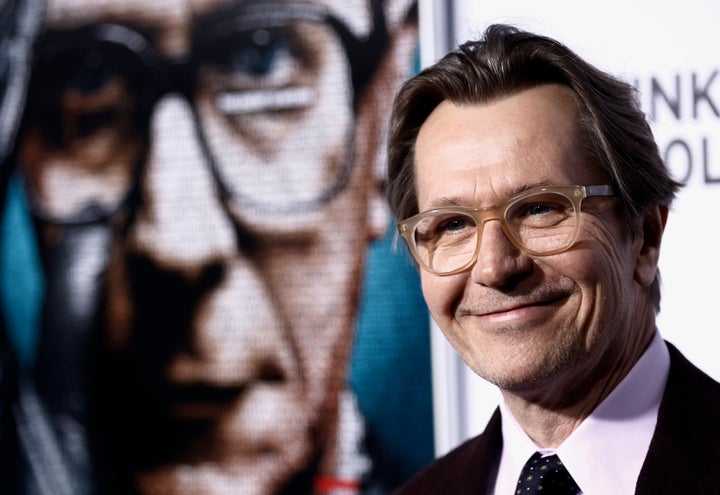
The process of adapting Tinker Tailor Soldier Spy began in a state of fear, which is perhaps appropriate for entering a world characterised by paranoia and dread.
John le Carré is something of a revered author, a writer who had taken the spy genre - formerly dominated by Ian Fleming's escapist James Bond books - and elevated it into literature. His fans are fiercely loyal and were understandably skeptical of the news that his most beloved novel was to be turned into a movie. "Tinker Tailor" had been adapted once before, in a 1979 BBC miniseries broadcast in seven hour-long episodes - and been hailed as a masterpiece. How could the same story be told in two hours with any fidelity?
And then there was the book. Le Carré's characters are unheroic (his most famous character, George Smiley, is described as "small, podgy and at best middle-aged"), and their battles are psychological rather than physical. The world he creates is detailed, realistic (le Carré worked for MI5 and MI6, and knew the arena of Cold War espionage intimately), and is characterised by moral uncertainty rather than Manichaean simplicity. The book's plot is labyrinthine, layered, shifting; its tone is shot through with melancholy rather than triumphalism. All of this made it a fantastically rich reading experience, and a horrendously difficult prospect for film adaptation.
So when my wife Bridget O'Connor and myself got the call to ask if we'd be interested in trying an adaptation, our reaction was one of extreme nervousness. However, we found out that le Carré was involved in the project himself, and that a director was already attached; the Swede Tomas Alfredson had made the international hit "Let the Right One In," which we had seen and loved. We decided to go in for a meeting, telling ourselves that if there was any talk of updating the story, or adding guns and car chases, then we wouldn't do it. We needn't have worried. Tomas turned out to be as different from the cliché of the "movie director" as it is possible to imagine. He coupled the impenetrable calm of Smiley himself with flashes of wicked humour. We liked him immediately. The producers Tim Bevan, Eric Fellner, and Robyn Slovo were also clearly excited at the idea of making a grown-up movie, and throughout the whole process were keen that we remained true to the spirit and complexity of the book. There would be no car chases.
Working with Tomas was a little like working on a project with a mad professor. Instead of the usual studio notes on "characters arcs," "three-act structure," and "dramatic stakes," Tomas would begin a script meeting by wondering what kind of fairy story "Tinker Tailor" would be; the good Prince who is thrown out of the castle and must defeat the usurper King, we decided. Another meeting began with Tomas arriving with a chess set he had just bought. Which character was which piece, he wondered? We spent the afternoon playing with that idea - and the chess pieces made it into the script. Other notes included his telling the cinematographer Hoyte van Hoytema that the film should look like the smell of wet tweed. (He told me that world should have the color of an old man's foreskin. I haven't actually seen an old man's foreskin, but I took the point.)
We met with David Cornwell, a.k.a. John le Carré himself, who turned out to be everything an adaptor could hope for from an author - generous, supportive and brilliantly inventive. He had been through the process of having his books adapted many times, and knew very well that fidelity to the source material alone was no guarantee of a successful movie. Far less precious about the novel than Bridget and myself, he encouraged us to move away from the text - and to play with new ideas and structures.
The initial drafts came fairly quickly and within something like six months we were green-lit. The process of refining, restructuring and polishing continued up to the beginning of the shoot - around about a year's writing in all.
The adaptation process differs from book to book, but in the case of "Tinker Tailor," it involved a kind of mosaic work. The structure of the novel was broken into pieces. Some long sequences would remain intact - Peter Guillam stealing the files from the Circus, for example - but in other cases we would take a line or event from one place in the narrative and move it elsewhere, shifting the fragments around endlessly until it felt right. The goal was to create a new version of the narrative which would bear a close family resemblance to the source material, but have its own cinematic personality. The really difficult part was not fitting the plot into two hours but doing it without losing the tone; to give the film the same autumnal, melancholy pace, and to give the script air and silence.
As the drafts progressed it became evident where new sequences, scenes and images would have to be injected. Bridget, who was endlessly inventive, came up with many of these ideas - from Guillam's homosexuality to the new café scene at the opening to the simple but eloquent image of Smiley swimming in the ponds at Hampstead Heath, looking at the trembling elderly bodies around him and wondering if this was his world now.
Adaptation is a kind of foster parenting, and as the filmmaking process continues you find yourself handing over the baby and watching it being taken away by new parents.
Throughout the shoot, the edit, and the early screenings - and up to the final release - a vague sense of nervousness continued. Unusually for me (because the job is not, in the end, to please the author), I found myself worrying about le Carré and whether or not he would approve of the film. At the U.K. premiere, Gary Oldman (who portrays Smiley) asked him if he liked what he'd seen. "I'm chuffed to fuck," came the reply. I finally stopped worrying.
